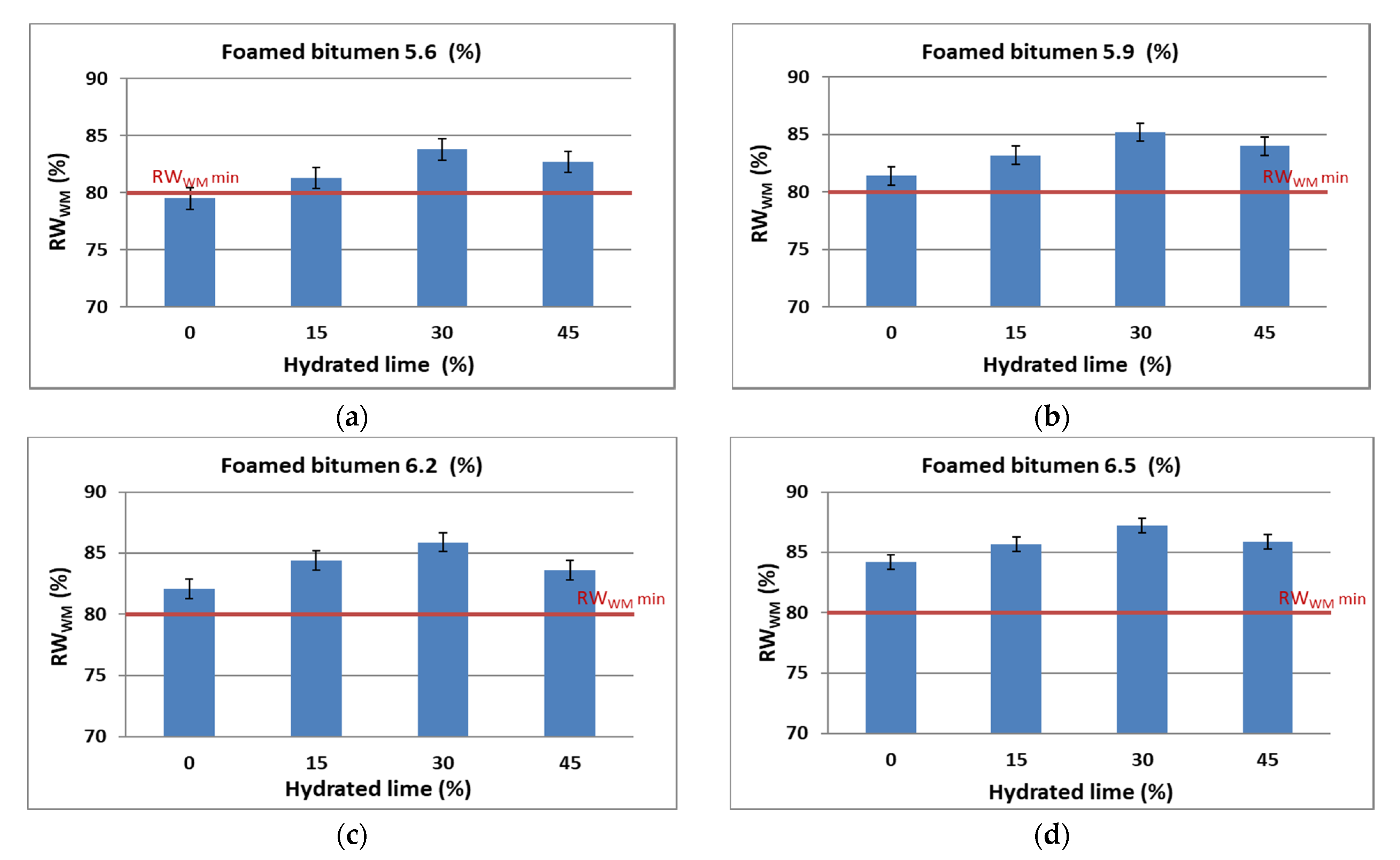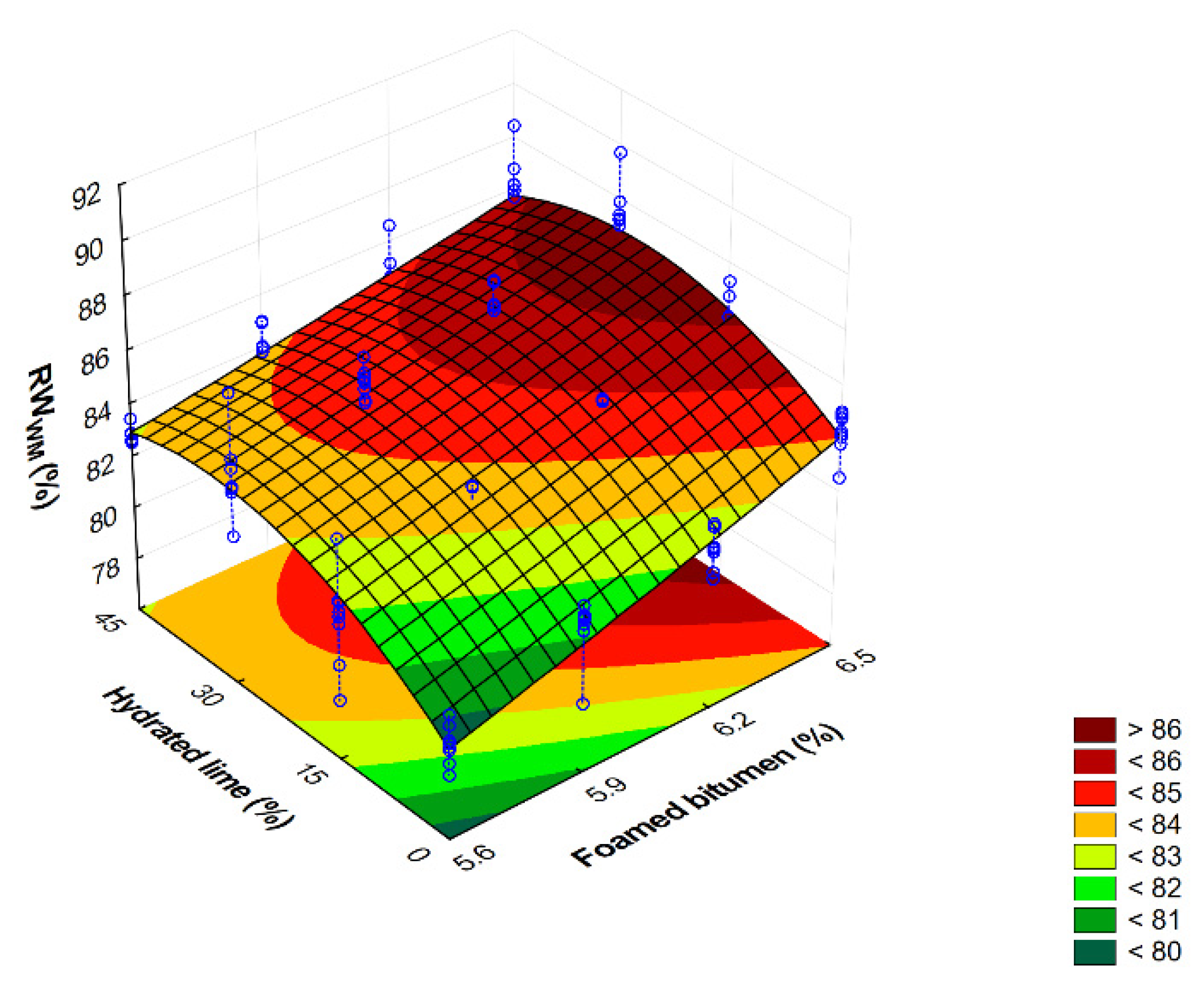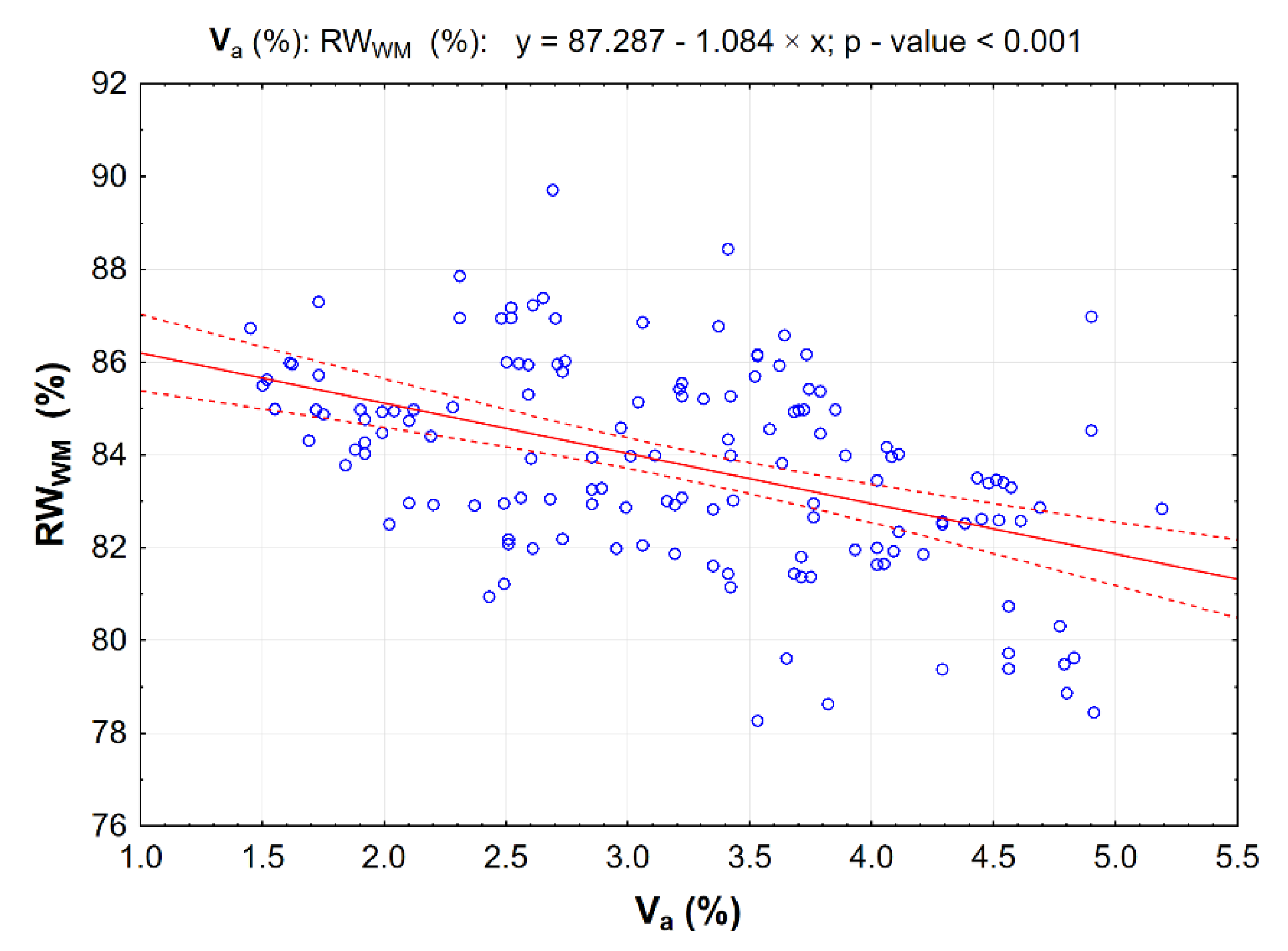3.2.1. Water Sensitivity According to WT-2 2014
The procedure for assessing water sensitivity of an asphalt mix according to the requirements of WT-2 2014 [
58] has only one freeze-thaw cycle on water-saturated specimens. The basis for the assessment is the ITSR, which should be greater than 90% for the bituminous mixture designed for the wearing course to be resistant to moisture and frost. When the mixture is characterized by high fineness and rather high binder content, this ratio reaches a value greater than 100% [
58,
64].
In the first stage of AC 8 moisture and frost resistance assessment, first the indirect tensile strength ITS
d for unconditioned specimens and then ITS
w for moisture-conditioned specimens were determined to WT-2 2014 [
58]. The test results are summarized in
Table 7 and graphically represented in
Figure 6.
An increase in the 50/70-grade foamed bitumen content in the AC 8 S mixture lowers ITS
d and ITS
w values, which is in line with the general trend in this respect. The use of hydrated lime increases ITS
d and ITS
w. With 5.6% binder in the mixture, this relationship only occurs with the addition of 15% hydrated lime. When its content increases, the value of the analyzed parameter decreases. This may be due to the high concentration of hydrated lime and a small amount of binder, which stiffens the AC 8 S mixture. Higher hydrated lime content tends to increase ITS
d and ITS
w. This trend increases with the amount of hydrated lime increased to 30%. It is most likely the effect of a favorable improvement of the binder adhesion to the aggregate and its interaction as a mineral lime filler with very small particle size [
61]. Increasing the hydrated lime content to 45% has a negative effect as a result of introducing too much fine-grained material and insufficient amount of binder to coat it, leading to excessive stiffening of the mixture. Attention should be paid to adsorption at the interface between the strongly basic mineral material (hydrated lime) and the binder, which contributes to a decrease in the content of "free binder" in the structure of the mixture [
61]. This further increases its rigidity and lowers the values of ITS
d and ITS
w [
40].
Overall, with the binder content of 5.9% and hydrated lime content of 30% in the AC 8 S HWMA mixture, the indirect tensile strength ITS
d and ITS
w met the normative requirements of WT-2 2014 [
58] most favorably.
To comprehensively describe the relationship of indirect tensile strength ITS
d and ITS
w of the AC 8 HWMA mixture with foamed bitumen 50/70, 0.6% SAA and hydrated lime, the second-degree polynomial model was adopted. In the first stage of model assessment, the significance test was performed using ANOVA [
63] (
Table 8).
Analysis of the parameters listed in
Table 8 indicates clearly that foamed bitumen and hydrated lime constitute a factor that has a significant effect on the indirect tensile strength, ITS
d and ITS
w, of the AC 8 S, as demonstrated by
p-values being less than the pre-defined significance level α = 0.05. Statistical significance was not observed in the assessment of linear effects of hydrated lime on ITS
d and foamed bitumen on ITS
w. Interactions found between the foamed bitumen and hydrated lime contents also affect the value of this parameter (
p-value less than α = 0.05).
The parameters describing the regression model for ITS
d and ITS
w of AC 8 S as a function of the amounts of foamed bitumen and hydrated lime are given in
Table 9.
The adjusted coefficient of determination R2 of the model for ITSd and ITSw is nearly 53%, which confirms the adequacy of the model. Both the amount of foamed bitumen 50/70 alone and the amount of hydrated lime alone have a significant impact on the flexural tensile strength, ITSd and ITSw of the AC 8 HWMA mixture. An interaction of these factors is observed (p-value is less than the pre-defined significance level α = 0.05).
Graphic representation of the variation in the ITS
d and ITS
w values of the AC 8 S mixture in terms of foamed bitumen and hydrated lime is shown in
Figure 7.
Analysis of the results presented in
Figure 6 confirms that with an increase in the amount of foamed bitumen and hydrated lime, the value of dry tensile strength ITS
d as per WT-2 2014 [
58] reaches a maximum at a 6.2% bitumen content in the mixture. At the same time, hydrated lime has a significant impact on the ITS
d in virtually the entire dosing range.
A comprehensive analysis of the results based on the assessment of the relationship presented in
Figure 7 shows that as the amounts of foamed bitumen increase and at hydrated lime increase from 15% to 30%, the wet tensile strength ITS
w of the specimens conditioned as per WT-2 2014 increases significantly [
58]. Please note the synergy of hydrated lime and foamed bitumen that significantly affect the ITS
w of the mixture.
Assessment of the resistance of the AC 8 S mixture to climatic factors according to WT-2 2014 is based on the ITSR expressed as the ratio of the tensile strength of moisture-conditioned specimen to the tensile strength of air-conditioned specimen (ITSw/ITSd).
The methodology developed as per WT-2 2014 assumes that the AC 8 S bituminous mixture is resistant to climatic factors (water and frost) when the ITSR reaches at least 90% [
58].
Graphic representation of the ITSR as a function of technology used, the amount of binder, and the hydrated lime content is shown in
Figure 8.
Analysis of the test results indicates that the AC 8 S mixture is resistant to moisture and frost in the entire range of use of 50/70-grade foamed bitumen with 0.6% SAA and hydrated lime—the ITSR always reaches values higher than 90%. The variation in its value depending on the constituents used (foamed bitumen, hydrated lime) is analogous to that of ITSd and ITSw.
Overall, it was observed that with 5.9% binder and 30% hydrated lime in the filler, the AC 8 S asphalt concrete has obtained the greatest increase in the water sensitivity described by the ITSR. The mixtures with higher binder contents have yielded slightly higher ITSR results; however, the high bitumen content could be a concern as for the resistance to permanent deformation performance and cost of such mixtures.
The relationship between the moisture resistance of the AC 8 HWMA mixture with 0.6% SAA modified 50/70-grade foamed bitumen and hydrated lime was described using the second-degree polynomial model. In the first stage in the model assessment, the significance test was performed using ANOVA variance analysis [
63] (
Table 10).
Analysis of the parameters listed in
Table 10 indicates clearly that foamed bitumen and hydrated lime contents constitute a factor that has a significant effect on the indirect tensile strength ratio ITSR in the AC 8 S, as demonstrated by the
p-values being less than the pre-defined significance level α = 0.05. No statistical significance was observed only in the case of the quadratic component of the model, related to the bitumen amount, and of the interaction term.
The parameters describing the regression model of the ITSR of the AC 8 S as a function of foamed bitumen and hydrated lime contents are given in
Table 11.
The adjusted coefficient of determination R2 is nearly 58%, which indicates the adequacy of the model. Hydrated lime has a significant effect on the value of ITSR for the AC 8 S HWMA mixture (p-value is less than the pre-defined significance level α = 0.05). A deviation from the presented trend exists for the linear relationship between the lime and the linear and squared terms related to the foamed bitumen content in the mixture.
Graphic representation of the variation in the ITSR value of the AC 8 S mixture in terms of the contents of foamed bitumen-grade 50/70 and hydrated lime is shown in
Figure 9.
Comprehensive analysis of the results based on the relationships shown in
Figure 9 indicates clearly that the contents of foamed bitumen increasing from 5.9% to 6.5% and hydrated lime increasing from 0% do 30% have a significant effect of increased ITSR, which corresponds to the resistance of the AC 8 S mixture to water and frost as per WT-2 2014 [
58]. An interaction effect between the hydrated lime and foamed bitumen provides the mixture with water and frost resistance.
At the same time, it is important to determine the correlation between the air void content V
a and ITSR (
Figure 10).
The correlation presented is linear and statistically significant, as the p-value is less than the pre-defined significance level α = 0.05.
3.2.2. Resistance to Water Damage According to the Modified AASHTO T283 Method
The procedure of assessing moisture and frost resistance according to the modified AASHTO T283 method consists of subjecting specimens of the bituminous mixture to 18 freeze-thaw cycles. In comparison with WT-2 (one freezing cycle), this procedure is more severe in terms of exposure of asphalt concrete to climatic factors. The simulation of the in-service conditions is closer to natural conditions. Thus, the results of moisture and frost resistance tests according to the modified AASHTO T283 method represent the behavior of the mixture in real conditions better than those obtained from the WT-2 2014 procedure.
The moisture-induced damage resistance (AASHTO T283) is reflected in the value of RWwm, which is defined as the indirect tensile strength of moisture-conditioned specimens divided by the indirect tensile strength of dry specimens.
In the first step of the assessment of AC 8 S moisture e resistance as per AASHTO T283, indirect tensile strength tests for dry (ITS
dA) and moisture-conditioned specimens (ITS
wA) were performed, as shown in
Table 12. Graphic representation of the results is in
Figure 11.
Analysis of the results of flexural tensile strength ITS
dA for the dry-conditioned AC 8 S mixture indicates that hydrated lime up to 30% increases the analyzed parameter for the HWMA mixture. Increasing its content to 45% leads to a decrease in ITS
dA. With increasing concentration of the binder in the mixture, the value of the analyzed parameter decreases, which is consistent with the observations made so far [
33].
It should also be noted that the presented trend of dry indirect tensile strength (modified AASHTO T283) ITS
dA for the AC 8 S in terms of the applied technology, amount of binder, and hydrated lime content has the same character as that obtained from the WT-2 2014 procedure [
58].
It can thus be concluded that a favorable flexural tensile strength was obtained with the 5.9% binder content (bitumen 50/70 + 0.6% SAA by weight) and 30% concentration of hydrated lime in the filler added to the AC 8 S HWMA mixture.
Analysis of the results of the effect of 50/70-grade bitumen content with 0.6% SAA and hydrated lime on the flexural indirect tensile strength ITSwA of the moisture-conditioned mixture indicates that they exhibit the same trend as those from “dry” conditioned specimens.
Overall, the binder content of 5.9% and hydrated lime content of 30% in the AC 8 S HWMA mixture resulted in a favorable flexural tensile strength.
Comprehensive description of the relationships of ITS
wA of the AC 8 S HWMA mixture with foamed 50/70 bitumen, 0.6% SAA addition and hydrated lime was prepared using the second-degree polynomial model. The first stage of the model evaluation involved performing a significance test using the ANOVA [
63] (
Table 13).
Analysis of the parameters compiled in
Table 13 shows that the contents of foamed bitumen and hydrated lime constitute a significant factor affecting the indirect tensile strength ITS
dA and ITS
wA of the AC 8 S, as the
p-values are less than the pre-defined significance level α = 0.05. No statistical significance was observed for the quadratic terms related to the binder effect.
No interaction effects were found between the foamed bitumen content and hydrated lime content. This can be attributed to the stringent conditioning of the specimens as a result of which this factor did not show a significant effect on the parameter. Consequently, statistically significant synergy of the hydrated lime and foamed bitumen did not occur.
The values describing the parameters of the regression model of the response surface for the indirect tensile strength ITS
dA and ITS
wA of the AC 8 S mixture in terms of the foamed bitumen and hydrated lime contents are summarized in
Table 14.
The adjusted coefficient of determination R2 for ITSdA is nearly 62% and 60% for ITSwA, which indicates the adequacy of the models. Hydrated lime has a significant influence on the dry indirect tensile strength ITSdA of the AC 8 S HWMA mixture (p-value is less than the pre-defined significance level α = 0.05).
Hydrated lime (p-value is less than the pre-defined significance level α = 0.05) has a statistically significant effect on the indirect tensile strength ITSwA of the AC 8 S HWMA mixture. However, no effect of the foamed bitumen content and no interaction between the contents of bitumen and hydrated lime were observed, which seems to be a consequence of rigorous conditions of specimen conditioning in the freeze-thaw process.
Graphic representation of the variation in the flexural indirect tensile strength ITS
dA and ITS
wA of the AC 8 S mixture versus the contents of foamed 50/70-grade bitumen and hydrated lime is shown in
Figure 12.
Comprehensive analysis of the results based on the response surface shown in
Figure 12 indicates that increasing the content of foamed bitumen and the content of hydrated lime from 15% to 30% has a significant effect on the increase in wet indirect tensile strength ITS
wA of the AC 8 S mixture (the modified AASHTO T283 procedure).
The resistance of the AC 8 S mixture to climatic factors as per AASHTO T283 is assessed based on the RW
WM, which is an ITS
wA/ITS
dA ratio. Calculation results are shown graphically in
Figure 13.
According to the methodology developed based on the modified AASHTO T283 procedure, a bituminous mixture is resistant to climatic factors—moisture and frost—when the RWWM is at least 80%.
Analysis of the results shows that increasing content of the binder in the AC 8 S mixture increases the value of RWWM, hence, the resistance to moisture damage. This response was expected and compliant with the general principles of asphaltic materials technology. The use of hydrated lime increases the value of this parameter and at 30% lime in the limestone dust, the resistance to moisture, and frost satisfies the requirements. A further increase in the lime content decreases the value of this parameter which can be attributed to a significant increase in the specific area of the filler (mineral dust + hydrated lime) in relation to the binder content.
A comprehensive description of moisture and frost resistance of the AC 8 S HWMA mixture with foamed bitumen, 0.6% SAA and hydrated lime was prepared using the second-degree polynomial model. The first stage of the model evaluation included a significance test using ANOVA variance analysis (
Table 15).
Analysis of the parameters presented in
Table 15 shows that the contents of foamed bitumen and hydrated lime constituted a significant factor that influenced the moisture and frost resistance (RW
WM ) of the AC 8 S mixture, as demonstrated by the
p-values being less than the pre-defined significance level α = 0.05. This relationship was not observed only for the square term describing the influence of bitumen content. The existence of interaction between the content of foamed bitumen and hydrated lime, which influence the analyzed parameter (
p-value is less than α = 0.05), is important, as it supports the use of foamed bitumen and hydrated lime in the mixture.
The value of the adjusted R
2 is almost 76%, which indicates the adequacy of the adopted model. The parameters of the developed regression model of the relationship between the RW
WM of the AC 8 S mixture and the foamed bitumen and hydrated lime contents are presented in
Table 16.
Analysis of the parameters listed in
Table 16 shows that hydrated lime is a significant factor influencing the resistance of the AC 8 S mixture to moisture, characterized by the RW
WM, as the
p-value is less than the pre-defined significance level α = 0. An interaction exists of the influence of foamed asphalt and hydrated lime with respect to the RW
WM (
p-value less then α = 0.05) as per the modified AASHTO T283 method.
Graphic representation of moisture and frost resistance relationship model—RW
WM (AASHTO T283) of the AC 8 S HWMA mixture in terms of foamed asphalt and hydrated lime contents is presented in
Figure 14 together with the developed model.
Comprehensive analysis of the results based on the relationship shown in
Figure 12 indicates that the contents of foamed bitumen increasing from 5.9% to 6.2% and hydrated lime from 15% to 30% have a significant effect on the RW
WM increase, which corresponds to the resistance to moisture and frost (modified AASHTO T283). Hydrated lime and foamed bitumen interact to provide resistance to moisture-induced damage.
To assess the effect of hydrated lime and 50/70-grade foamed bitumen with an addition of 0.6% SAA on the properties of the AC 8 S bituminous mixture, the correlation between the air void content V
a and resistance to water and frost RW
WM (
Figure 15) was analyzed.
The statistically significant correlation between the air void content Va of AC 8 S and its resistance to water and frost (RWWM) has a linear character (p-value less than α = 0.05).

























